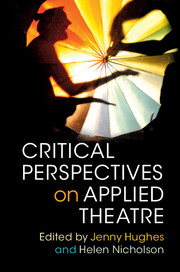Book contents
- Frontmatter
- Contents
- List of figures
- List of contributors
- 1 Applied theatre: ecology of practices
- PART I HISTORIES AND CULTURAL MEMORIES
- 2 Toward a historiography of the absent: on the late pasts of applied theatre and community performance
- 3 A pre-history of applied theatre: work, house, perform
- 4 Applied theatre and cultural memory in East and Southeast Asia
- 5 Dear Nise: method, madness and artistic occupation at a psychiatric hospital in Rio de Janeiro
- PART II PLACE, COMMUNITY AND ENVIRONMENT
- PART III POETICS AND PARTICIPATION
- Notes
- Index
- References
5 - Dear Nise: method, madness and artistic occupation at a psychiatric hospital in Rio de Janeiro
from PART I - HISTORIES AND CULTURAL MEMORIES
Published online by Cambridge University Press: 05 April 2016
- Frontmatter
- Contents
- List of figures
- List of contributors
- 1 Applied theatre: ecology of practices
- PART I HISTORIES AND CULTURAL MEMORIES
- 2 Toward a historiography of the absent: on the late pasts of applied theatre and community performance
- 3 A pre-history of applied theatre: work, house, perform
- 4 Applied theatre and cultural memory in East and Southeast Asia
- 5 Dear Nise: method, madness and artistic occupation at a psychiatric hospital in Rio de Janeiro
- PART II PLACE, COMMUNITY AND ENVIRONMENT
- PART III POETICS AND PARTICIPATION
- Notes
- Index
- References
Summary
In 1995, the Brazilian psychiatrist Nise da Silveira wrote seven letters to Baruch Spinoza. Already in the ninetieth year of a pioneering life dedicated to psychiatric reform, the heroine of the anti-asylum movement and former colleague of Carl Jung used her correspondence with a seventeenth century Dutch philosopher to reflect on the interconnections between ethical, artistic and scientific questions that had fascinated her since she first graduated in Medicine in the 1920s. There could be no answer to her letters or to the questions that she raised, beyond the need to keep asking them even as she faced the end of her own life.
In 2014, we (Paul Heritage and Silvia Ramos) wrote three unsolicited letters to Nise da Silveira because the questions that she asked with such rigour and passion – and for which in the final years of her life was awarded Brazil's highest cultural and human rights prizes – remain as necessary today as they were for Nise as she sought to breach the divisions between arts, medicine and life. One of us, Silvia Ramos, is a Brazilian sociologist, with a background in public health policy. She has been a government special advisor on issues of security, citizenship and human rights and has developed a series of research projects on young people and violence. The other, Paul Heritage, is a theatre practitioner and academic from London, who has been working between Britain and Brazil for the last twenty-three years.
Paul Heritage
London
25 September 2014
My dear Nise,
You are unique. Your death in Rio de Janeiro at the age of 94 in the final year of the twentieth century has not diminished the reverberations of your deeply philosophical and unashamedly poetic revolution. A psychiatrist who invited us not to seek to cure ourselves beyond what is necessary, you knew that we all have a little madness within us and would be more boring if completely cured. We continue to need doctors like you, who temper certainty with the artistry of the unknown and unknowable. In your quest for a better understanding of madness and of art you became a correspondent with Carl Jung in the 1940s, exploring with the founder of analytical psychology what you discovered as a medical doctor about the use of the arts as a means of understanding chronic psychosis.
- Type
- Chapter
- Information
- Critical Perspectives on Applied Theatre , pp. 82 - 104Publisher: Cambridge University PressPrint publication year: 2016

